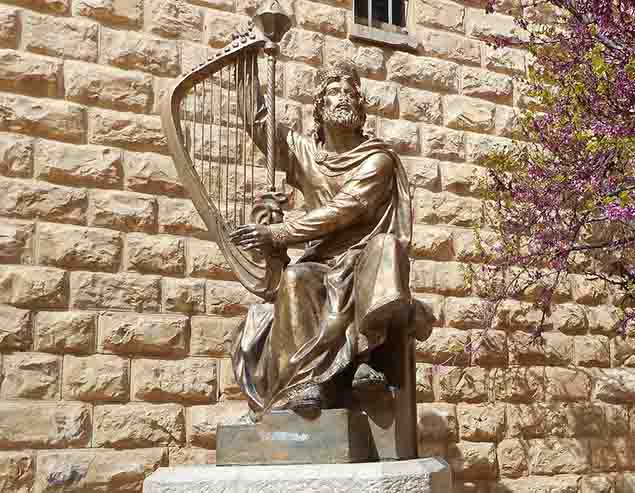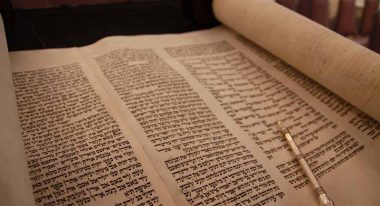
Jewish Music in the Biblical Period
The history of musical art in modern Israel apparently begins in the times prior to the arrival of Jews in the land of Israel. Considering the close relationship between cultures of the Mediterranean and in particular the Semitic peoples, the Shorter Jewish Encyclopedia assumes likeness between the music of Ancient Israel and that of its neighbors – the Phoenicians, Egyptians and Mesopotamians. And at the same time, building on the fundamental differences between the monotheist Jews and other peoples of the region, possible differences are also noted.
Archaeological finds allow us to talk about music of the cultures that preceded the Jewish one or coexisted with it in the territory of modern Israel. Thus, among the archaeological finds made in the area of Megiddo is presented the drawing on a plate, made 4,000 years ago, depicting a man playing a stringed instrument. The image was made in the Canaanite period. The Philistine vessel for perfumed oil, demonstrated at the Museum of Ashdod, is decorated with four statues of musicians playing different instruments. During the excavation of Philistine Ekron was found a sistrum, and in Megiddo were discovered bronze cymbals, dating back to 1200-1000 years BC, and an ivory plate of the same period, whose characters include a musician playing the lyre.
Unlike other cultures, along with the archaeological finds Jewish music in ancient Israel has a number of written testimonies to be judged by. Despite the sparseness of references to music in the era of the First Temple, we can still talk about the important role it played in the culture of Ancient Israel, based on biblical sources.
The Book of Genesis mentions Jubal (Yuval), the son of Lamech, who “was the father of all who play stringed instruments and pipes” (Genesis 4: 21). In total, the Old Testament mentions at least 24 different musical instruments belonging to the four main groups, although in most cases compliance with modern instruments is only suspected:
– idiophones (percussion instruments in which the sound source is the body itself – cymbals, sistrum, bells, rattles)
– membranophones (percussion instruments with stretched skin – drums or tambourines)
– wind musical instruments (ugav flute, whistles, trumpet-hatzotzra, horn and shofar that survives today in its historical form; in the era of the Second Temple the three ways to extract sounds from the shofar during religious rites were regulated)
– stringed musical instruments (Kinnor lyre, Nevel harp, also later, in the Hellenistic period, psantrin, playing which possibly seemed like playing the harp, and among unidentified instruments there are ten-stringed Hazor and seven-stringed Kinnor, which is considered to be akin to a violin).
Apparently, the main task of musical instruments was to accompany vocal songs and melodies and sacred texts reading. This is indicated by the frequent use of the common name kley zemer or kley shirah in Hebrew (כלי זמר, כלי שירה), which translates as “tools for singing”.
According to the Bible, music became a part of the Temple ritual since King David. Musicians were trained at the Temple, and they later formed into a separate category of priests. The main genre of ritual music is a psalm, a syncretic musical-poetic genre, the first examples of which are attributed to David. By the end of the Second Temple period hymns were sung in three main ways: solo, choir (as an option for which had already formed antiphon – a “dialogue” between the two groups of performers), and the responsive singing, which is a dialogue between the soloist and the chorus. Detailed descriptions of the Temple service of that period, including the number of musicians, exist in Talmudic literature, Josephus and the Qumran scrolls.
Attitude to music as an art among the Jews, however, has not always been positive. For example, shortly before the Babylonian captivity, as well as during it, the spiritual leaders of the Jewish people condemned music lessons as unworthy for the people in distress and called them one of the causes of that captivity: “… The harp and the strings, The tambourine and flute, And wine are in their feasts; But they do not regard the work of the Lord, Nor consider the operation of His hands. Therefore my people have gone into captivity…” (Isaiah 5: 12-13)
The negative attitude to music, especially the instrumental, as a separate art can also be seen in the later biblical sources, in particular, in the Book of Ecclesiastes, where among the frills that the author allowed for himself, is also listed the fact that he got for himself “singers, both men and women, and many concubines, the delight of the sons of man” (Ecclesiastes 2: 8). This attitude had been preserved among religious Jews, many centuries later: in “Shulchan Aruch”, a set of rules and laws of the middle of the second millennium AD, contains a ban on playing musical instruments on the Sabbath and holidays.






